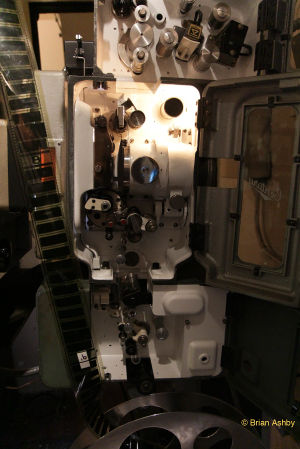| Welcome to Sprocket School! This project is maintained by volunteer editors. Learn more about how this works. |
Century JJ: Difference between revisions
No edit summary |
No edit summary |
||
| Line 1: | Line 1: | ||
[[File:Century_JJ.jpg|right|thumb|300px]] | [[File:Century_JJ.jpg|right|thumb|300px]] | ||
The Century JJ is the only Century projector that can project both | The Century JJ is the only Century projector that can [[:Category:Dual_gauge_projectors|project both 35mm and 70mm]]. | ||
==Avoiding film damage== | |||
The most common form of damage caused by Century JJs are '''[[slap scratches]]''', which appear as small tic marks on screen, usually in clusters if a print has been run several times on the same projector using the same threading pattern. | |||
Slap scratches occur in two areas: the upper and lower loop. In the upper loop, 70mm prints can get slap scratches by hitting the upper 35mm roller, especially if the loop is too small. To avoid this, remove the 35mm roller and replace with a second 70mm roller. | |||
The lower loop is more complicated. Most Century JJs have a roller underneath the intermittent that acts as a stabilizer and prevents the film from hitting the top of the intermittent casing. Some projectors have additional rails that work to stabilize the lower loop, and consequently make it run more quietly. | |||
==External Links== | |||
* [http://www.film-tech.com/warehouse/index.php?category=2#Projectors Film-Tech manuals page] - A PDF manual for the Century JJ is available | |||
[[Category:Projectors]] | [[Category:Projectors]] | ||
Revision as of 13:56, 21 April 2020

The Century JJ is the only Century projector that can project both 35mm and 70mm.
Avoiding film damage
The most common form of damage caused by Century JJs are slap scratches, which appear as small tic marks on screen, usually in clusters if a print has been run several times on the same projector using the same threading pattern.
Slap scratches occur in two areas: the upper and lower loop. In the upper loop, 70mm prints can get slap scratches by hitting the upper 35mm roller, especially if the loop is too small. To avoid this, remove the 35mm roller and replace with a second 70mm roller.
The lower loop is more complicated. Most Century JJs have a roller underneath the intermittent that acts as a stabilizer and prevents the film from hitting the top of the intermittent casing. Some projectors have additional rails that work to stabilize the lower loop, and consequently make it run more quietly.
External Links
- Film-Tech manuals page - A PDF manual for the Century JJ is available